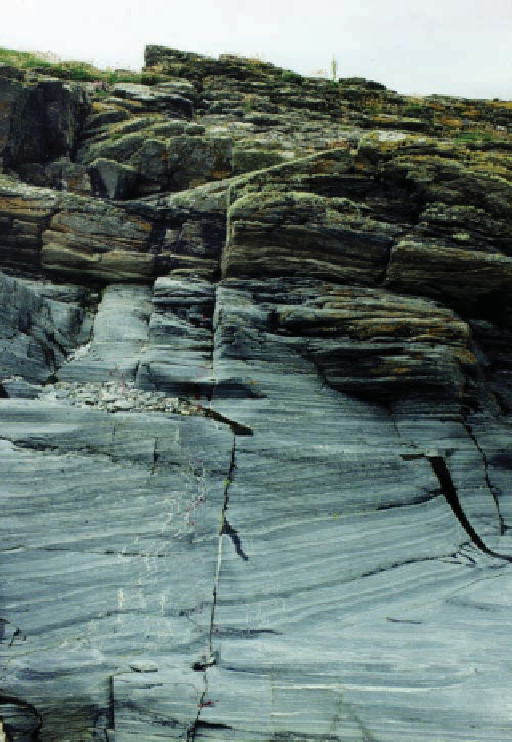Geology Reference
In-Depth Information
◗
Figure 16.8
Wave Erosion by Abrasion and Hydraulic Action
These waves pounding the California coast carry sand and gravel
and effectively erode by abrasion, that is, the impact of solid particles
against shoreline materials. In many areas sea cliffs undercut by
abrasion fail by mass wasting processes (see Figure 11.3).
b
The rocks in the lower part of this image on a small island in the
Irish Sea have been smoothed by abrasion, but the rocks higher up
are out of the reach of waves.
a
volume of sand in the system remains more or less constant;
it simply moves farther offshore or onshore depending on
wave energy.
The terms
winter beach
and
summer beach
, though
widely used, are somewhat misleading. A winter beach pro-
file can develop at any time if there is a large storm, and
likewise a summer beach profi le can develop during a pro-
longed winter calm period.
longshore currents where they weakened as they entered the
deeper water of a bay's opening. Some spits are modifi ed by
waves so that their free ends are curved; they go by the name
hook
or
recurved spit
(Figure 16.12a)
A rarer type of spit is a
tombolo
that extends out from
the shoreline to an island (
Figure 16.13). A tombolo forms
on the shoreward side of an island as wave refraction around
the island creates converging currents that turn seaward and
deposit a sandbar. So, in contrast to spits and baymouth bars,
which are usually nearly parallel with the shoreline, the long
axes of tombolos are nearly at right angles to the shoreline.
Spits, baymouth bars, and tombolos are most common
along irregular seashores, but they can also be found in
large lakes. Regardless of their setting, spits and baymouth
bars, especially, constitute a continuing problem where
bays must be kept open for pleasure boating, commercial
shipping, or both. Obviously, a bay closed off by a sandbar
is of little use for either endeavor, so a bay must be regu-
larly dredged or protected from deposition by longshore
◗
Beaches are the most familiar depositional features of coasts,
but spits, baymouth bars, and tombolos are common, too.
In fact, these features are simply continuations of a beach.
A
spit,
for instance, is a fingerlike projection of a beach
into a body of water such as a bay, and a
baymouth bar
is a
spit that has grown until it completely closes off a bay from
the open sea (
Figure 16.12). Both are composed of sand,
more rarely gravel, that was transported and deposited by
◗




Search WWH ::

Custom Search